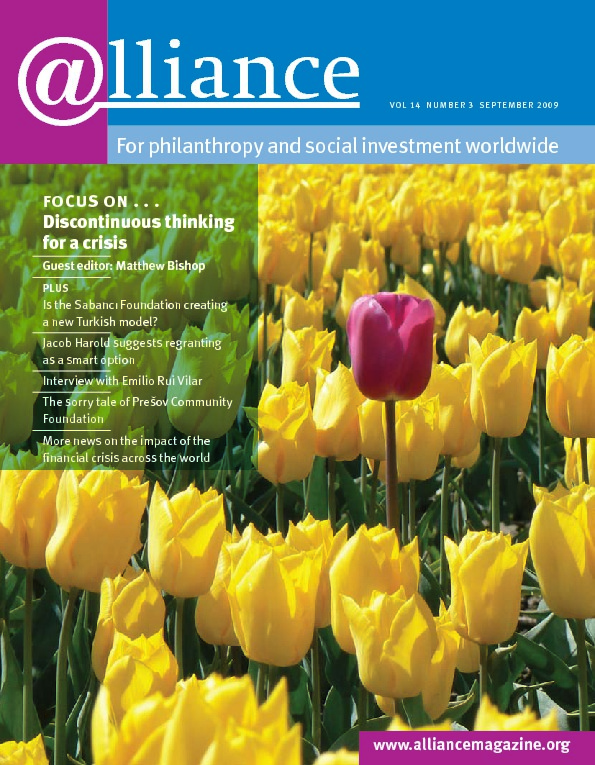I want to respond briefly to Barry Gaberman’s thoughtful analysis of the challenge of setting appropriate payout levels (Alliance, March and June 2009). Barry is right, of course, that payout requirements are only an issue if you believe that foundations should have the option of perpetual existence, but I believe the issues are more complicated than he suggests.
First, as Barry notes, setting the percentage of payout to maximize current giving while preserving the foundation’s purchasing power has long been hotly debated. The central issue, however, is asset allocation. If all assets were in US Treasury Notes, then a sustainable payout after inflation is no more than 1-2 per cent, at best. If all assets were in stocks, then a payout on the order of 8-9 per cent would be justifiable. And if, as most major foundations have chosen to do before the recent crash, the investment portfolio is a mix of high-risk and high-return hedge funds, derivatives and other complex investments, the payout above inflation could easily be 12 per cent or more – at least until last year. The reality is that most major foundations have met the payout requirement with ease during most of the past four decades and still grown their assets far in excess of inflation.
Rather than argue over alternative investment models and a single payout rate for all, why not mandate a payout equal to the actual investment returns earned minus the actual rate of inflation? Growth could be averaged over a period of years, as it is now, and losses could be carried forward or backward to adjust for unexpected changes in value. If the goal is to pay out all investment returns above inflation, that would be an easy law to write.
Or consider the formula California Community Foundation has used in the past: Subtract inflation from investment returns, reinvest half the excess for growth, and donate the other half as a one time ‘community dividend’.
Another issue that goes beyond whether 5 per cent is the right number or not is the option of using investments to further the foundation’s mission. Pioneers such as the F B Heron Foundation have roughly a third of their assets in investments that directly further their mission, and all investments have performed at or better than the relevant investment indexes. Heron has, in effect, multiplied its payout many times over by putting more funds to work for social benefit without sacrificing perpetuity. Why not reward foundations for mission investments by setting a higher payout rate for non-mission investments, in essence, expanding the PRI rules that already exist?
I also note that most foundations choose perpetuity as the default option in establishing a foundation. I would suggest that it is not appropriate for all foundations. Smaller foundations in particular often find that legal, accounting and other administrative costs eat up a disproportionate share of assets over time. The dispersal of family members makes it much harder to focus the giving in meaningful ways. Relatively few foundations under $250 million have established long-term staffing and governance models that ensure a level of focus and impact equivalent to the donor’s or first generation’s leadership and vision.
Finally, there are institutions that must be perpetual by virtue of their mission. Museums are intended to preserve our cultural heritage and universities are intended to transmit knowledge across generations. Some foundations may also have missions or strategies that require multi-generation activities and a century-long perspective. The vast majority, however, respond to more immediate needs with shorter term contributions. Apart from the donor’s understandable desire to immortalize his or her name, which could equally well be accomplished through endowment gifts to major institutions, most of the 70,000 US foundations would have a hard time explaining why perpetuity is essential to their social missions.
It is easy to argue the value of perpetuity in the abstract, and the rationale for a one-size-fits-all 5 per cent rule. If one examines more carefully the opportunities and responsibilities of a charitable foundation’s social mission, however, there are many reasons to consider alternatives.
Mark R. Kramer
Managing Director, FSG Social Impact Advisors
Barry Gaberman’s two recent columns take up the oft-discussed topic of payout and perpetuity for foundations. Unfortunately, he fails to (1) move the debate forward and (2) discuss the most fundamental objection to a payout rate that allows perpetuity. In the first case, he simply rehashes the same arguments that have been circulating for the last 30 years (the last time the payout rate was seriously examined by the US Congress). In the second case, he fails to address why public policy should encourage perpetuity as a philanthropic option.
As Mr Gaberman notes, it is certainly legitimate for a donor to want to leave a cross-generational legacy. But he offers no explanation as to why public policy should encourage this. Just as a foundation can voluntarily spend down its endowment by exceeding the mandated payout rate today, why not allow a donor to express their cross-generational will with after-tax dollars? The only explanation for why public policy should encourage perpetuity through tax exemption is if there is greater public benefit to perpetuity than more rapid payout. In 100 years of organized philanthropy there is as yet no evidence of this. Until someone can prove the public benefit of perpetuity, there is no reason why the mandated payout rate should not be raised – crisis or no.
Timothy Ogden
Editor-in-Chief, Philanthropy Action



Comments (0)